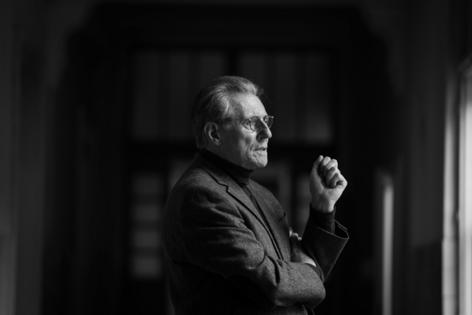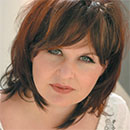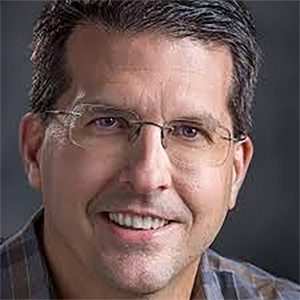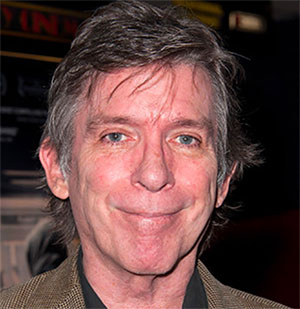Gabriel Byrne wasn't sold on playing Samuel Beckett. Then he read 'Dance First'
Published in Entertainment News
When the Irish actor Gabriel Byrne was first approached to play the role of Samuel Beckett, one of Ireland's greatest literary heroes, he hesitated.
"I wrestled with the idea," Byrne says on a recent video call from his home in Maine. "You know, screen biography is a very particular kind of genre, and for the most part people tend to imitate, walk, do wigs, all that kind of stuff.
"But this script wasn't about an impersonation," he says of Neil Forsyth's screenplay for the new film "Dance First." "It was about a kind of surreal examination of the kind of man that Beckett was. A very, very private man who suffered a great deal emotionally throughout his life. Very insecure in many ways."
Beckett, who left Ireland as a young man to live and write in Paris for most of his life, seemed a mystery worth solving on screen, Byrne says.
"His private mask very, very few people got to see," he says. "So he became this figure of fascination among people.
"So this was an attempt to get to grips with the private, emotional Beckett," Byrne says. "And for that reason, I thought, yeah, this is better than doing a straightforward impersonation, though I understood that could alienate people as well."
Director James Marsh, an Oscar winner for the documentary "Man on Wire," felt a similar pull to the project once he realized it was not a typical Famous Person biopic. ("The Theory of Everything," Marsh's 2014 film about theoretical physicist Stephen Hawking, is a similarly creative biopic with an equally challenging protagonist.)
"I started reading it, and the first two or three pages were very conventional," says Marsh on a video call from his home in Denmark. "You start with Beckett at the Nobel Prize ceremony where he's getting the Nobel Prize for literature (in 1969).
"You think, OK, one of those. We'll start with the great moment and — I could see it all unfolding," he says. "But that scene very quickly becomes something very, very different.
"You end up not in a Nobel Prize ceremony but somewhere completely different after a kind of Buster Keaton sequence that takes you out of that environment and puts you in a very different place.
"Then, before you know it, this Beckett character you've seen at the Nobel Prizes, is talking with someone who looks exactly like him, who's the Other Beckett," Marsh says. "Who's his alter ego, his inner voice made real, however you want to describe it."
That, Marsh says, was the moment he decide he would not toss the screenplay on the reject pile, but read on and on until he was convinced he had to make the film.
"Dance First" opens Friday, Aug. 8. It's name is drawn from Beckett's philosophy for life, "Dance first, think later," a modification of a line in the play "Waiting For Godot," his best-known and most frequently staged work. (Last week, it was announced that Keanu Reeves will make his Broadway debut in "Godot" next year opposite Alex Winter, his co-star in the "Bill & Ted" movies.)
The film is not so much an examination of Beckett's writing process, or the plays, short stories and novels, as it is the story of the relationships that shaped, with chapters focused on his mother, the Irish writer James Joyce and his daughter Lucia, his wife Suzanne, and his mistress Barbara.
"I knew a bit about Beckett's life," Marsh says. "I knew some of his plays. But the actual life story was surprising.
"I didn't know much about his time in the Resistance (during World War II)," he says. "I didn't know he'd been stabbed by a pimp for no particular reason. So these are the kind of things you think, 'This is someone who writes the way he writes, a minimalist, very stripped down.' Yet his life was so full of romantic adventure and surprising drama and violence."
Unmasking Beckett
"It's very hard to be an actor and not know about Beckett, though I had never performed in any of his plays," Byrne says. "He had a kind of storied reputation in Dublin. He lived in a place called Foxrock, which is about four or five miles from where I lived. Our area was more working class, and Beckett was actually middle to upper middle class.
"And he stayed there until he was about 22, 23 when he left for Paris," he says. "He lectured at Trinity College, so there were people around who had been taught by Beckett, and they would tell you stories about him.
"There was one I heard of some guy walking around Killiney Beach and meeting Beckett coming the opposite direction. It was a lovely, warm, sunny day. Beckett passed, and he said, 'Good morning, Mr. Beckett.' And Beckett said, 'Well I wouldn't go that far.'
"So he had this reputation of being utterly unknowable, and people didn't know whether the stories about him were real or not real," Byrne says.
The distant reputation, the challenging nature of his work, and a handful of famously austere photographic portraits of Beckett all contributed to the imposing facade that Marsh and Byrne hoped to slip behind.
"During the French Resistance, just to digress into the film, at a certain point we see him as part of an ambush of a German convoy," Marsh says. "But the convoy doesn't show up so they can't do the ambush.
"And 'Waiting For Godot' is written in 1948, I think, or very shortly after the war," he says. "You kind of feel like these experiences during the war, and maybe that's one of them, had a big influence on the portrait of the world that you see in that play."
Later in the film, a clear line is drawn between Beckett's relationships with his wife and his mistress and the play titled "Play," in which a man, his wife and his mistress stand inside giant funeral urns as they recite their chorus of dialogue.
"He was tortured by his relationship with Barbara, and he was very unhappily married," Byrne says. "And I think he poured a great deal of that angst into his work."
For those with any amount of knowledge of Beckett's work, the film offers Easter eggs, some more obvious than others, to discover, Marsh says.
"You can kind of go, whoa, that's interesting," he says. "I kind of know where that might connect within his work."
'The only choice'
Once Marsh decided to make the movie there was only ever one actor he considered for Beckett.
"Early on, I said, 'Well who can do this?' And Gabriel popped into my head almost straight away," Marsh says. "He was the only choice I ever had, and I kind of told myself if he says no I'm not going to do this. I thought he was the only person worth talking about it."
Through a mutual friend, Marsh and Byrne met via Zoom during the pandemic, talking about the screenplay and their visions for making it.
"He's got the same question I've got about, Should we even be doing this?" Marsh says. "So we went in, we were holding hands, basically, to this project. For me, the reason for doing the film was that Gabriel wanted to do it, and we're going to do this together."
Byrne is not the only actor who plays Beckett in the film. There are several child actors for his youngest days, and Irish actor Fionn O'Shea plays him from his college days through World War II. But Byrne is present even in those earlier parts of the movie thanks to the creative decision to have him reflecting back on the regrets of his life in conversation with himself.
When Beckett leaves the Nobel Prize ceremony, he ends up in a kind of purgatory — the real-life setting is an otherworldly subterranean quarry outside of Budapest — talking with his Other Beckett alter ego, both of them played by Byrne.
"They should never be so different from each other, but they had to be recognizably the same kind of physical presence," Byrne says of the dual Becketts he plays in those scenes. "I don't know if you talk to yourself, but I've been talking to myself since I was 10. And what that really is is just the inner voice given volume."
Filming the scenes of Beckett and Other Beckett was difficult Marsh says. With a small budget for the film, there was no money for green screens or other technical tricks, so the effects are practical, created entirely inside the camera.
"There's Gabriel on one side of the frame — it's all in-camera — with a tennis ball on a stick opposite him," Marsh says, laughing. "He talks to the tennis ball and then we flip it around. It didn't work very well, and Gabriel found the whole thing a little bit disconcerting."
So Marsh stood in for the tennis ball to give Byrne a human to play off, and later an assistant director took over that role, and slowly the scenes came together.
"He'd be able to kind of warm up the character," Marsh says. "Then there's a costume change between the two (Becketts), which was an absolute nuisance because you'd have to save the camera, preserve it, no one can touch it. He had to go behind a rock and in an undignified way change his clothes. It's too far to go back to base.
"But then it became actually part of the way it worked. We said, 'OK, we can stop here and put on the new costume and become the new version of the character. So by the afternoon of this first awful day it started to kind of become really quite interesting.
"But all credit to Gabriel for pulling it off, because it wasn't easy," Marsh says of the dual character scenes that were the first days of shooting for the film. "He has to be Beckett straight away, but Beckett times two. Beckett with a twist. So it was difficult."
Regret and shame
The majority of the film is shot in a gorgeously vintage black-and-white, with color used only for the final chapter of Beckett's life. Marsh says it was a choice inspired in part by his 1999 debut feature documentary, "Wisconsin Death Trip," and part by the budgetary restrictions of "Dance First."
"It felt like going back to the beginning all over again, with a tiny budget, a black and white film," he says. Which is a very different kind of aesthetic choice. You're dealing with composition more. In black and white composition is vital."
That decision also allowed him to include other influences including images inspired by early 20th century photographers in Paris such as Brassaï and Eugène Atget, Marsh adds.
For Byrne, the film underscored a feeling that Beckett's life was not often a happy one, and that throughout it, as we see when the two Becketts look back over his life, he felt great regret and shame.
"Did he have much joy in his life? I suspect not," he says. "I think he was tormented, for sure. He was a very insecure man with not a great deal of self esteem.
"And what he valued most was his work," Byrne says. "Because everything of him went into that work, but not in an obvious way. He redefined literature and theater through the way he expressed himself. But that feeling of shame for something that you never actually did? I don't know how to explain that."
©2024 MediaNews Group, Inc. Visit ocregister.com. Distributed by Tribune Content Agency, LLC.













Comments